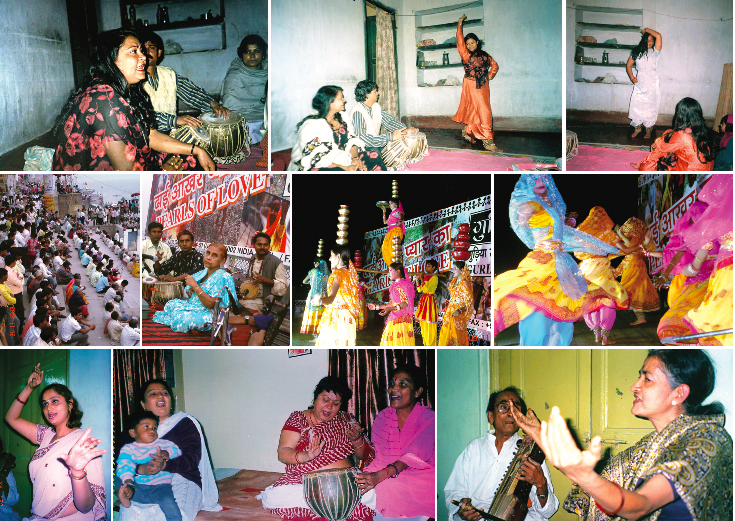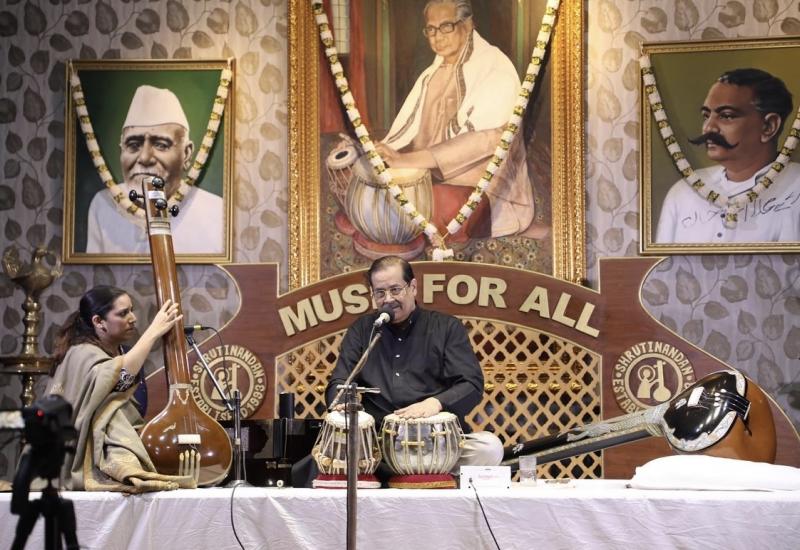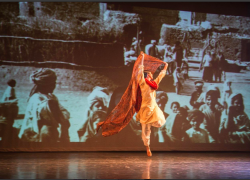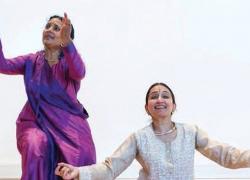Guria: Supporting traditional artists in North India
“In spite of being a mother, sister, daughter,
My caste is still ‘Woman’” [1]
Varanasi was once a centre of tawaif (traditional courtesan) culture, where hereditary professional artists were respected for their artistic contributions and were able to move back and forth between their own community and mainstream society. With the loss of elite patronage, this power and relative security was lost and artists became further marginalised and vulnerable to sexual exploitation. Ajeet Singh, the founder of Guria, a grass-roots organisation working in northern India, and musician and ethnomusicologist Amie Maciszewski talked to Gopa Roy about Guria’s work.
VARANASI, WITH ITS LARGE TOURIST INDUSTRY and geographical location, has long been a centre for human trafficking and child exploitation. As a teenager there, Ajeet Singh saw the need for action and went on to found the NGO Guria in Shivdaspur, the red-light area of Varanasi, to help women and children escape prostitution. As well as victim rescue, the organisation provides legal assistance, conducts public-awareness campaigns and supports the education of women and the children of sex workers. Child prostitution has now virtually been eradicated in Shivdaspur. Guria’s blogspot states: “We respond to immediate suffering as well as investigate the root causes of prostitution, poverty and inequality. We believe in a multi-faceted approach to fighting this deeply-entrenched problem.”
As part of this multi-faceted approach, Guria has been organising regular concerts entitled Dhai Akhar Pyar Ka, ‘Pearls of Love’ (Kabir’s phrase). Ajeet explains: “Guria has organised a total of twenty concerts since 1995 with the aim of providing marginalised traditional women artists from red-light and other areas with a platform, to give them dignity and an alternative livelihood, to safeguard their dying musical traditions and to raise awareness about sex trafficking.”
The first concerts took place in prestigious theatres in Varanasi, New Delhi, Bhopal, Lucknow and Mumbai, with the support of high-profile personalities, “in order to get social sanction”. Then, strategically, in the source areas of sex trafficking in Uttar Pradesh. “This not only helps in the prevention of sex trafficking but gives a stronger sense of roots and of ownership of the semi-classical and folk music traditions among the rural people. We strongly believe that music can be a very important tool for change.”
Ethnomusicologist Dr Amie Maciszewski, who has conducted field research on hereditary professional women musicians and dancers, says: “ the women tend to specialise in regional genres, most popular among them Bhojpuri, a folk genre (which includes music as well as dance) that has now become commercialised. Secular qawwali is also popular, often sung by Muslim women and girls.” Maciszewski makes the point that this enables women to perform as part of an ensemble, with men, in somewhat de-sexualised contexts.[2]
What have reactions from the audiences been like? Ajeet: “Earlier when we had artists exclusively from red-light areas we faced lewd remarks and security problems from orthodox groups.” A 2004 concert was banned because of pressure from the right-wing Shiv Sena. “Even families hesitated to come to the show... It was difficult to get these women respect, though people thronged the venue when the same performers performed in the traditional settings like marriages, festivals, fairs and of course the red-light areas.”
Guria’s aim is to enable participants to be valued for their art. However, commercial viability is proving difficult to achieve: “We have already formed an independent group of ten women and eight accompanists to give them a sense of ownership but,” Ajeet says, “they don’t get regular programmes throughout the year.” Maciszewski explains that part of the difficulty is “the present-day reality of tawaifs’ relatively unrefined performance styles (due to lack of access to training in classical music) and entanglement with prostitution.” [3] Nevertheless, as these two case studies show, Guria’s work is of unparalleled value to the women themselves:
Ms Karima (name changed). Vocalist. Age: 52. Home: Muzaffarpur red-light area, Bihar
I sing thumri and dadra, and folk songs from Uttar Pradesh and Bihar. I learned from my ustad in the red-light area and from my mother. My mother sang classical songs and she took me to all the programmes and evening singing sessions for the clients. Till the very last days of her life she used to make me sing with her for hours. I have a group of women whom I lead now but we don’t get enough programmes. Guria has taught us that we and our singing traditions are also important and that there is nothing to be ashamed of.
Ms Adti Bai (name changed). Dancer. Age: 33. Village: Sukh Karar, Raisen, MP
I dance rai which is performed by the Bedia community in Madhya Pradesh. [4] My mother taught me from early childhood and she took me to all the programmes, especially the marriages. I used to dance with her throughout the night. I continue this even today to earn a livelihood. I am part of the group created by Guria. Guria has taught us that we are also important and that there is nothing to be ashamed of in our singing traditions. They always guide us to pull out from the sex trade and believe in our dance traditions but this does not help us to get enough for survival. I have also taught Ajeet-bhai the rai dance. He has lived with us for the last twelve years. This makes all the village women feel very good and important. No one has ever lived with us as part of our families.
Notes:
1 From a song performed by qawwali singer and folk theatre actress Poonam Naz at Guria’s ‘Pearls of Love’ concert in 2004. Quoted in Amelia Maciszewski, ‘Texts, Tunes and Talking Heads: Discourses Surrounding Socially Marginal North Indian Musicians’, in Katherine Butler Brown & Laudan Nooshin, eds, Twentieth-Century Music Journal, Vol. 3, issue 1 (Cambridge, CUP, 2007), pp.121–44.
2 Ibid., Maciszewski.
3 Ibid., Maciszewski.
4 Women have traditionally provided the economic backbone in this community with their sex work.
Photo credits: Top and bottom rows: Maria Stahl | Centre row: Courtesy Guria
Links
Disrupted Divas – Conflicting Pathways 2010 Documentary film by Amie Maciszewski highlighting the lives and music of several tawaifs. Available from underscore records
Specks of Dust Documentary film about Guria made by Princeton students.
First published in Pulse Issue No. 125, Summer 2014


















